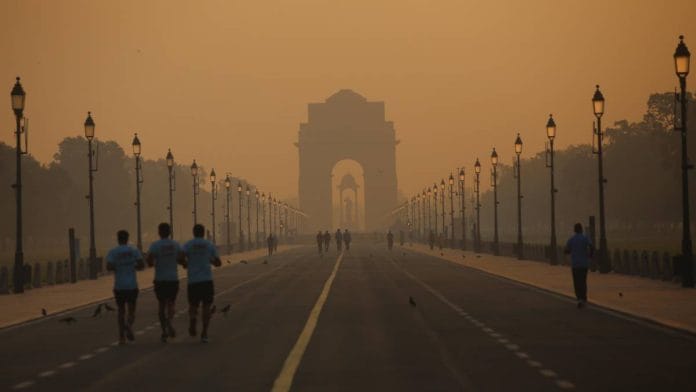New Delhi: A warm October and strong winds came to the rescue of Delhiites this Diwali as the air quality index (AQI) in the national capital showed only a marginal spike despite a night of cracker-bursting. With the mean temperature being 1.23 degrees Celsius above normal, this was the warmest October since 1901, the India Meteorological Department (IMD) said Friday.
The Central Pollution Control Board (CPCB) bulletin showed that the AQI in Delhi Friday—a day after Diwali—was 339, only 11 points higher than the value recorded Thursday (328). The readings of both days are categorised as ‘very poor’ on the CPCB scale.
Data showed that when cracker-bursting began picking up in Delhi-NCR Thursday evening, pollution levels spiked in several neighbourhoods. In areas like RK Puram, Anand Vihar, Nehru Nagar, Sonia Vihar, Punjabi Bagh, Okhla and Rohini, the increase in the levels of pollutants was the most jarring.
In Nehru Nagar, for instance, the levels of PM 2.5—ultrafine particulate matter with a diameter less than 2.5 micrometres—rose from 205 micrograms per cubic metre at 7 pm Thursday to 1,527 micrograms per cubic metre at midnight. In Sonia Vihar, the levels went from 129 to 754 micrograms per cubic metre.
However, by Friday, the accumulation of pollutants had started to ease.
From 1,527 micrograms per cubic metre, the PM 2.5 levels came down to 72 micrograms per cubic metre by 6 pm Friday. This was all thanks to favourable weather conditions.
Barring 2022, this was one of the lowest impacts seen on the air quality of Delhi a day after Diwali. In 2023, the AQI went up from 218 on Diwali night to 301 a day after. In 2021, it climbed from 382 to 462.
In 2022, the AQI levels improved from 312 to 302 after Diwali. This improvement was also attributed to good weather.
What helped this year
According to IMD officials, an early Diwali, a warmer-than-usual October and favourable winds played a significant role in preventing the air quality in Delhi from dipping to emergency levels because these factors helped with better air circulation.
IMD data showed that almost the entire day Thursday, wind speeds over Delhi-NCR remained between 12 and 16 km per hour, which helped disperse existing pollutants that had been affecting the air quality for the last few days. By evening, the winds slowed to 3 to 7 km per hour but picked up again to about 10 to 12 kilometres per hour Friday.
According to the data, the average maximum temperature over northwest India in October was 32.32 degrees Celsius, as against the normal 30.72 degrees Celsius.
Mahesh Palawat, vice-president (meteorology and climate change) at Skymet Weather, a private weather forecasting service, told ThePrint that conditions are expected to remain the same over the next few days.
“Currently, northwesterly winds are blowing over Delhi at a speed of around 10 to 12 km per hour, helping with timely pollution dispersion. Conditions are not expected to change much in the coming days,” he said.
(Edited by Radifah Kabir)
Also Read: 2024 Physics Nobel for AI scientists. How they pioneered machine learning modelled on human brain






